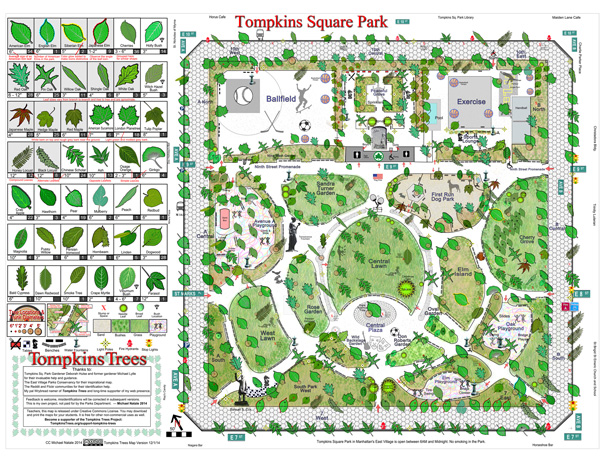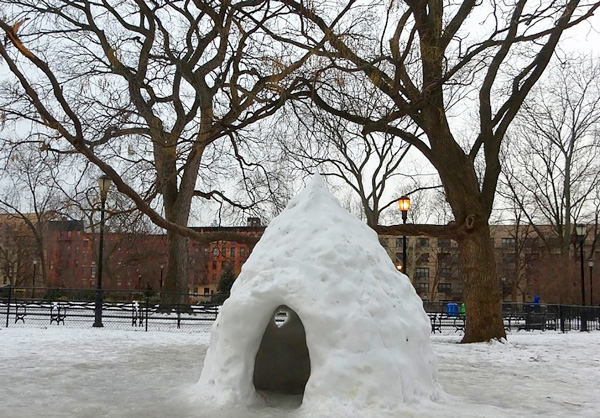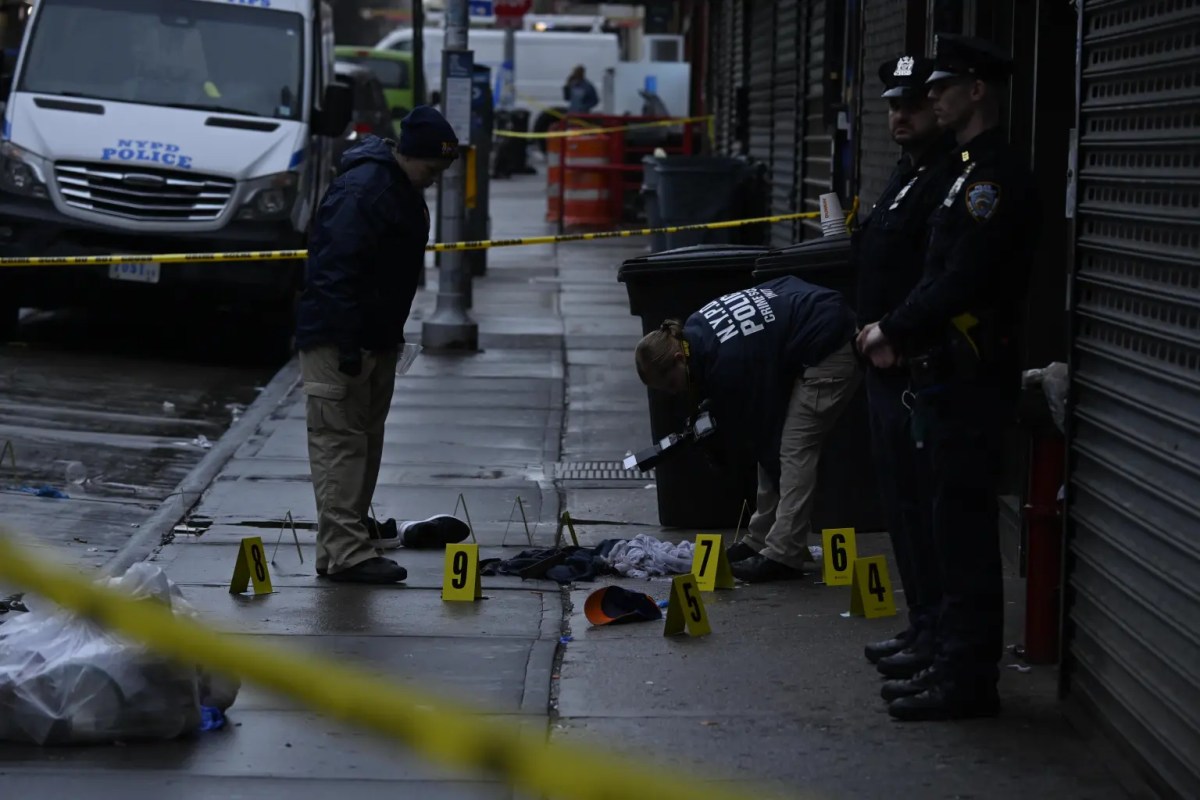
BY MICHAEL LYDON | Now that’s my favorite tree in the park,” said Michael Natale one bitter cold February afternoon, pointing to a much-trimmed veteran standing tall at the southeast corner of Tompkins Square Park. “A black locust and one of Tompkins’s oldest trees.”
A squirrel stuck an inquisitive nose out of a deep fold in the tree’s gnarly brown bark, then ducked back inside. Natale chuckled.
“The squirrels’ favorite tree, too — so many crevasses they can hide in!”
We wandered serendipitously across the park toward the Ninth St. promenade, bundled up against the wind but drinking in the sight of dozens of trees reaching high into the winter-blue sky, their leafless branches silhouetted by the golden afternoon sunlight.
Near the semicircle of benches bordering the central lawn — a sunbather’s heaven in July, now a sheet of snow and ice — we passed a noble willow oak, tall, straight and graceful. But Natale kept pointing out more modest beauties: a grove of newly planted cherry trees near Avenue B, the Chinese Scholar trees along Seventh St., and a robust linden just south of the Temperance Fountain.
He also made sure we paused by the semicircle for a moment to mourn “Bendy,” a low-leaning American elm that had lived for decades as the modest pal of the “Hare Krishna Tree,” the tall elm beside it.
“I hated seeing Bendy cut down last September,” Natale said quietly. “But the park’s arborists did extensive tests that convinced me that Bendy’s toppling was a real danger, particularly in a high wind.”
Nearby he pointed out a massive twist in an iron fence along one of the park’s many pathways.
“And a falling branch did that, not a whole tree!”
Getting a tour of Tompkins Square Park’s trees guided by Michael Natale felt like a rare treat because Natale is the park’s Amerigo Vespucci, a mapmaker who spent four years first surveying the 550 leafy beings (not counting many low bushes and hedges) that reside in the park’s 10 and a half acres, and then rendering their location, genus and size in precise and illuminating detail.

A heavyset fellow with a shock of gray-black hair and a friendly smile, Natale is both modest about and proud of his accomplishment.
“As I was beginning, I read an article about two fellows who took two years to put out a book mapping Central Park’s trees,” he said. “So, I figured, if they could do huge Central Park in two years, I could do tiny Tompkins in a few months.” He laughed ruefully. “Little did I know!”
A Philadelphia native, Natale has lived in the East Village since the ’70s, paying his rent as a housepainter, and photographing Soho street art as a hobby. He’s seen Tompkins go through successive waves of change: punk rock blasting from the old band shell in the ’70s, homeless men and women camped in cardboard boxes along the park’s pathways in the ’80s, drug dealers openly hawking their wares decade after decade.
After the “police riot” in August 1988, the city closed the park to break the downward spiral. When reopened in 1992, Tompkins felt like a brand-new park: children running and laughing in three new playgrounds, dogs frolicking in the city’s first dog run, and New Yorkers of all ages and colors sitting on the freshly painted benches, quietly chatting and watching the world go by.
One of many East Villagers who considered the park a blessing not a blot, Natale started bringing his digital camera along on his afternoon strolls; soon he found the park’s flora as fascinating as its fauna.
“Tompkins, I realized, was the neighborhood’s only sizable patch of green,” he said, as we passed the snow covered ping-pong table. “I fell in love with these beautiful trees and began to wonder, what kind of tree was this one, that one? The Tompkins Square Park Conservancy had a tiny map with a few indications of trees, but it was way out of date, not helpful for serious study. So in 2011, I decided, O.K., I’ll make my own map and make it available to everyone.”
Natale started surveying the park, pacing off distances and measuring sections of the wrought-iron fences to give his map an accurate scale: Unlike most urban “squares,” he discovered, Tompkins is a nearly perfect square. The park’s current and former head gardeners, Deborah Hulse and Michael Lytle, answered his questions when they could and steered him to more-knowledgeable sources when they couldn’t.
He researched the history of the park, a salt marsh when owned by Peter Stuyvesant and then by Daniel Tompkins, a governor of New York and James Monroe’s vice president. The City of New York acquired and drained the land in 1834. Yet after making it a public square in the 1840s, the city cut down the park’s trees in the 1860s to make a parade ground for New York’s Seventh Regiment. A few sycamores were spared, and three of those still survive: the two large sycamores on the park’s 10th St. northern boundary, the third on Avenue A between Eighth and Ninth Sts.
Fortunately, the city reversed its scorched-earth policy in 1878, planting 450 trees and giving the park the overall design we know today.
Working on the map became an engrossing labor of love for Natale.
“I learned by doing,” he said with a smile.
He consulted tree books and could soon recognize and draw more than 40 leaf shapes. He became versed in digital drawing, but found that Google Maps didn’t help him much: “They took their pictures in the summer when leaves hid crucial details.”
Tompkins, he learned, had lost 34 American elms to Dutch elm disease since the 1930s, but thankfully 54 of the elms remain, the oval leaves on their towering branches giving welcome shade through the spring, summer and fall.
Oaks are the park’s next most common tree: 28 red oaks, 25 pin oaks and 11 willow oaks, followed by 28 Japanese and 25 hedge maples, then dwindling down to one bald cypress, one pussy willow and the one tall spruce in the central lawn that becomes the park’s brightly lit Christmas tree every December.
On the map, Natale noted every tree with a tiny picture of its distinctive leaf shape, and he often added brown circles of varying sizes to indicate each trunk’s diameter. Yet scientific accuracy didn’t stifle his playfulness. A woman in a bikini tells us that sunbathers love the central lawn, an electric guitar shows where rock bands play on summer Sundays, and swirling pink and blue lines in the playgrounds represent giggling boys and girls playing tag and hide-and-seek. Natale also made up plain but affectionate names for the park’s many islands of greenery — Cherry Grove, Elm Island and Rose Garden — and the map points out where to find the basketball hoops, the ping-pong table and the sprinklers in Peaceful Grove, a popular spot for summertime birthday parties.
The sun had sunk below the buildings on Seventh St., and our fingers and toes were getting cold — time to go home! In the ice-covered ball field at 10th St. and Avenue A, a fellow kept throwing a green tennis ball for an indefatigable golden retriever, which raced to scoop up the ball with its teeth, then trotted back to his human, dropped it, and looked up panting, eager for another run.
A dad watched his daughter dig into a Peaceful Grove snow pile with her red mittens. A flock of teenagers laughed and larked their way along the Ninth St. promenade toward Avenue A.
We said our goodbyes, and Natale set off back across the park toward Avenue B. Above us, the elms and oaks, maples and pear trees swayed in the chill evening breeze. Patience, patience, their silent wisdom seemed to say; winter may now have us in its icy grip, but springtime buds and blossoms, gentle breezes and green leaves, short sleeves and sandals, are unstoppably on their way.
Copies of Michael Natale’s map of the trees of Tompkins Square Park’s trees are available in several sizes at https://tompkinstrees.org/support-tompkins-trees .
There’s a PayPal link on the page with prices for each size, as well as directions on how to print your own map, plus an appeal request for donations, so Natale can continue his worthy work to document, photograph and spread the word about the beauties of the park’s plant and animal life.

















